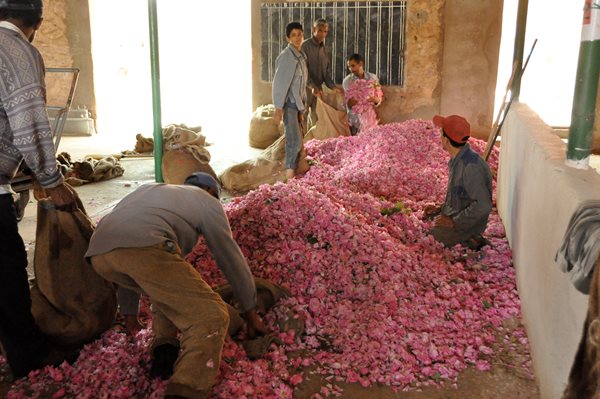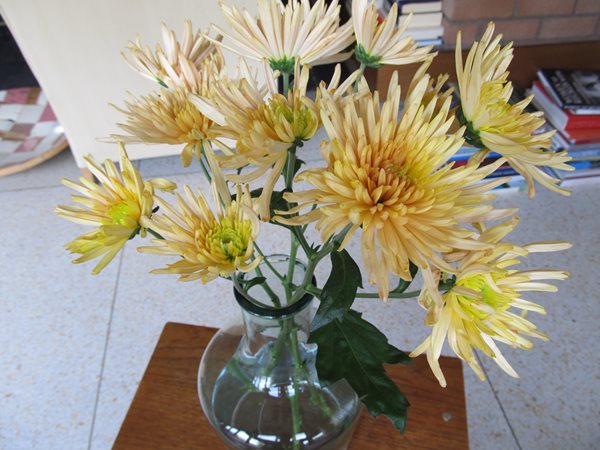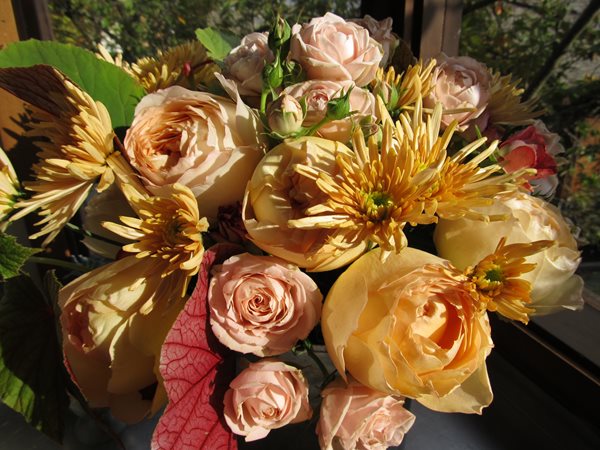Morocco On My Mind - Flowers
Katherine Anderson, our flower columnist, visited Morocco for her 40th birthday and shares with us her beautiful photographs of the colors and landscape that she saw on her trip, as well as three flower arrangements that she created using Morocco as inspiration.

This past spring, my husband and I drove in a semi-circle, from Fez, the medieval capital of Morocco, out to the Sahara Desert, and then back toward Marrakech. It was a 40th birthday trip (mine) and I found what I was looking for: a country saturated on so many levels with color, design, sunshine, and fragrant food.
In this month's column I put together a slide show of photographs from my trip, as well as some photographs of a few different flower arrangements that I put together inspired by the colors of Morocco.
Marigold and Mint is an organic farm, a retail shop, and a studio. The farm is situated along the Snoqualmie River, about 30 miles east of Seattle and the shop is located in the Melrose Market on Capitol Hill in Seattle, Washington. Founded in 2008 by owner Katherine Anderson, Marigold and Mint reflects her lifetime love of flowers and landscapes. Trained as a landscape architect, she brings her affection for both clean and clear design and intricate patterns to Marigold and Mint.

On my organic farm near Seattle, Washington, I grow, among other things, herbs and edible flowers that I sell at my shop, Marigold and Mint.
In Morocco, I wanted to experience a culture that consumes healthy doses of fresh herbs on a daily basis. And to my pleasure, the mint, lemon verbena, and scented geranium—even fresh absinthe—were piled high in the markets.


From there we drove south, over the Erg Chebbi dunes of the Sahara toward the Skoura Oasis in the Dades Valley, the place with that fairy-tale name. Our destination was Les Aromes du Maroc—the largest producer of rose oil and rose water in the country—in the town of Kelaa el Megouna, site of May’s annual rose festival.
Inside the distillery, a trim man named Mohammad explained how the damask rose—a thorny old plant with exceptional fragrance—thrives in this climate. During a 40-day harvest, tons of rose petals are plucked from massive hedgerows and brought to the distillery. Behind Mohammad, muscular men scattered armloads of pink petals onto a concrete floor, where they were bagged, weighed, and loaded into distillation tanks to create products for the international and local markets.
As we drove out of town, young boys selling rose garlands approached our car; we bought two strings for 10 dirham and half of our guide’s ice cream bar. As we watched the Valley of Roses disappear behind us, the boys kicked a soccer ball around a dusty field, their heads crowned with rings of roses.

In Fez, we followed the fleet and silent feet of our guide Ghali Berrada through the maze of the medina, where the street walls are the color of pale sand.


En route to the Sahara from Fez, we drove through the Middle Atlas mountains, where we passed fields of poppies (used for dye), saw stacks of clay pots on the roadside (indicating honey for sale), and came upon Bedouin encampments.

In the desert, the blue and beige of Fez took on a deeper quality, as if more intensely soaked, as opposed to washed, by the sun.


Fez is known as the blue city for the indigos seen everywhere (unlike the pinks seen in Marrakech) and the combination of blue and beige that I saw inspired me to put just a few pale chrysanthemums into a blue glass bottle.



At one of the casbahs near Ouarzazate, we stumbled upon a room covered in striped pillows and rugs from one of the tribal regions. I wish I could have packed every one in my bag. But we had to keep on going, across the High Atlas mountains to our final destination.

Marrakesh is as chaotic and colorful, with the market square Djemma el Fnaa serving as the heartbeat of the place. At night it lights up and vibrates with human energy. By day, orange juice sellers and snake charmers ply their wares. But around every corner in this city you will see women and men buying their herbs.

Everyone expects to see amazing mosaics in Morocco and we did. I was most drawn to mosaics that featured stars, a motif found throughout the Arab world.

Here, the stars are mixed in with floral motifs in this tile work.




To remember these stars I picked up this metal vessel in Marrakech.

Sticking a glass within, and filling it with deep yellow-orange ranunculus, reminds me of the trip, not just the stars in the walls, but also the warmth of the sun, the honey that came with my breakfasts in the riads (along with perfect homemade yogurt), and the orange trees.

I am ready to go back, but for now console myself in part with arrangements that remind me of the place. Making them gives me time to daydream of my spring trip. The last arrangement I made this week is soft and pulsating (see those veins in the begonia leaves), somehow soothing and alive like the country I fell for in my fourty-first year.

If you're interested in taking a trip to Morocco, here are some resources.
Our guide was Ghali Berrada. You can reach him at Lear_27@yahoo.com or call 212 076 17 34 20.
We stayed at Dar Ahlam, Skoura, 05 24 85 22 39 (A Relais & Chateaux hotel.)
To visit Les Aromes du Maroc, email contact@aromes.ma or call 212 5 22 89 69 15.




